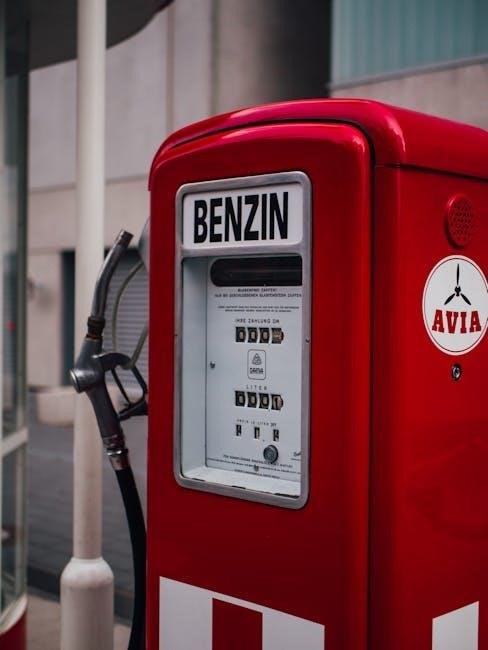TIPM fuel pump relay bypass kits offer a reliable solution to faulty TIPM modules, ensuring consistent fuel pump operation without modifying existing wiring or adding new cables.
What is the TIPM Module?
The Totally Integrated Power Module (TIPM) is a central electronic control unit managing various vehicle functions, including the fuel pump relay. It acts as a hub for power distribution and relay control, integrating multiple electrical systems into one module. The TIPM is responsible for activating the fuel pump relay, ensuring proper fuel delivery to the engine. However, its complex design and susceptibility to failures make it a common source of issues, particularly in vehicles like Dodge, Jeep, and Chrysler. When the TIPM fails, it can disable the fuel pump, leading to starting problems or engine stalling. Since the TIPM is not repairable, bypass kits or replacements become necessary solutions.
Why Bypass the Fuel Pump Relay?
Bypassing the fuel pump relay in the TIPM module is often necessary when the TIPM fails to control the fuel pump properly. A faulty TIPM can prevent the fuel pump from activating, leading to starting issues or engine stalling. Since the TIPM is typically not repairable, bypassing the relay provides a practical solution to maintain fuel pump operation. This method allows direct control of the fuel pump, ensuring consistent fuel delivery to the engine. While it may involve losing some original control features, it offers a reliable workaround to keep the vehicle operational without replacing the entire TIPM, which can be costly and difficult to obtain. Aftermarket kits are available, offering easier installation with minimal wiring changes, and they are designed to be compatible with specific vehicles to ensure safety and effectiveness.

Symptoms of a Faulty Fuel Pump Relay
A faulty fuel pump relay can cause the car to stall or fail to start, with the fuel pump not activating. Symptoms include intermittent operation or no fuel delivery, leading to starting issues or engine stalling.
Common Issues Caused by a Bad Relay
A bad fuel pump relay can cause the car to fail to start or stall intermittently. The fuel pump may not activate, leading to fuel starvation and engine shutdown. In some cases, the pump might run continuously, draining the battery. These issues often stem from the TIPM module’s failure to control the relay properly. Without a functioning relay, the fuel pump cannot operate consistently, resulting in unreliable vehicle performance and potential stalling during operation. Addressing these issues promptly is essential to avoid further complications.
How to Identify a Failing TIPM Relay
Identifying a failing TIPM relay involves observing specific symptoms such as intermittent starting issues, engine stalling, or the fuel pump not activating. Use a scan tool to check for fault codes in the TIPM module. Look for no power on pin 85 or issues with pin 86. Additionally, measure fuel pressure to confirm if the pump is functioning correctly. If the TIPM is faulty, it may not send the proper signal to the relay, leading to inconsistent fuel pump operation, which can be diagnosed through these methods to confirm the need for a bypass solution.

Components of a TIPM Fuel Pump Relay Bypass Kit
A typical bypass kit includes a wiring harness, connectors, relays, and detailed instructions for installation, ensuring a direct and reliable connection to the fuel pump system.
What’s Included in the Kit?
A TIPM fuel pump relay bypass kit typically includes a pre-assembled wiring harness, high-quality connectors, a heavy-duty relay, inline fuse, and detailed step-by-step instructions. The harness is designed to directly connect to the TIPM and fuel pump, ensuring a seamless installation process. No soldering or advanced tools are required, making it accessible for DIY enthusiasts. The kit is compatible with various Chrysler, Dodge, Jeep, and Ram vehicles, providing a reliable solution to bypass faulty TIPM relays and restore proper fuel pump operation.
Understanding the Wiring and Connectors
The wiring and connectors in a TIPM fuel pump relay bypass kit are designed to ensure a secure and reliable connection. The kit typically includes a pre-terminated wiring harness with OEM-style connectors that match the TIPM and fuel pump connectors. The wiring is color-coded for easy identification, and the connectors are sealed to prevent moisture ingress. The bypass system connects directly to the TIPM’s fuel pump relay circuit, rerouting power through a heavy-duty relay and inline fuse for added protection. Proper connection ensures uninterrupted fuel pump operation and eliminates the risk of electrical faults.
Installation Instructions for the Bypass Kit
Disconnect the battery, locate the TIPM and fuel pump connector, and connect the bypass kit according to the wiring diagram. Test the system before restarting the engine.
Step-by-Step Guide to Installing the Bypass
Begin by disconnecting the battery to ensure safety. Locate the TIPM module and identify the fuel pump relay connector. Carefully remove the connector and insert the bypass module. Connect the provided wiring harness to the designated terminals, ensuring secure connections. Reconnect the battery and test the fuel pump operation by turning the ignition key. Verify proper function before starting the engine. Follow the kit’s wiring diagram for accurate installation, and consult instructions if any issues arise during the process.
Important Safety Precautions
Always disconnect the battery before starting the installation to prevent accidental engine start or electrical shock. Ensure the vehicle is in park and apply the parking brake. Avoid touching electrical components without proper insulation to prevent short circuits. Use the correct tools and follow the wiring diagram carefully. Never ground the bypass kit improperly, as it may cause system malfunctions. If unsure, consult a professional or the instructions provided with the kit. Safety glasses and gloves are recommended to protect against potential hazards during the process.
Testing the Bypass System
After installation, turn the ignition to the “on” position and listen for the fuel pump engaging. Ensure no leaks and verify the pump operates only when necessary.
How to Verify Proper Installation
To confirm the bypass system is installed correctly, turn the ignition to the “on” position and listen for the fuel pump engaging. Check for proper fuel pressure using a gauge to ensure it matches specifications. Verify that the pump operates only when the engine is running and stops when the ignition is off. Additionally, monitor the system for any signs of malfunction, such as continuous pump operation or failure to start the engine. A successful installation should resolve fuel pump-related issues and prevent further TIPM failures.
Troubleshooting Common Post-Installation Issues
After installing the bypass kit, check for issues like continuous fuel pump operation or failure to start. Ensure connections are secure and free from corrosion. Verify the correct wiring configuration to avoid short circuits. If the pump doesn’t activate, inspect the fuse and relay for proper function. Consult the kit’s troubleshooting guide or manufacturer support for specific solutions. Addressing these issues promptly ensures reliable fuel pump operation and prevents further complications with the TIPM system.

Cost-Effective Solutions
TIPM fuel pump relay bypass kits provide affordable alternatives to costly TIPM replacements. DIY and pre-manufactured options are available, ensuring reliability without breaking the bank.
Comparing Different Bypass Kits
Different TIPM fuel pump relay bypass kits vary in design, ease of installation, and cost. Some kits are plug-and-play, while others require basic wiring knowledge. High-quality kits include durable materials and clear instructions, ensuring reliability. DIY solutions are budget-friendly but may lack the convenience of pre-manufactured options. When choosing, consider the kit’s compatibility with your vehicle, ease of use, and customer reviews. Kits with additional features, such as surge protection or status indicators, offer enhanced functionality. Always select a kit from a reputable brand to ensure long-term performance and avoid potential electrical issues.
DIY vs. Pre-Manufactured Kits
DIY bypass kits offer a cost-effective solution, requiring basic tools and wiring knowledge. They are customizable but may lack the convenience and reliability of pre-manufactured kits. Pre-manufactured kits are designed for ease of installation, often plug-and-play, and include detailed instructions. They are more expensive but provide a hassle-free experience and are built with durable materials. DIY kits are ideal for those with technical skills, while pre-manufactured kits are better for those seeking a quick, reliable fix without the risk of installation errors.

TIPM Fuel Pump Relay Bypass: Temporary Fix or Permanent Solution?
A bypass kit is often a temporary fix, addressing the symptom but not the root TIPM issue. However, a well-installed bypass can provide a reliable long-term solution.
Evaluating the Reliability of Aftermarket Kits
Aftermarket TIPM bypass kits vary in quality and reliability. It’s essential to research and compare kits, focusing on materials, durability, and user reviews. Reputable brands offering pre-manufactured solutions often provide better longevity. However, some DIY kits may lack proper engineering, leading to potential failures. Always verify the kit’s compatibility with your vehicle and check for any certifications. Reading forums and customer feedback can help identify trustworthy options. A well-designed bypass kit can offer a reliable solution, but caution is needed to avoid low-quality alternatives.
- Research the manufacturer’s reputation.
- Check for customer reviews and ratings.
- Ensure compatibility with your vehicle’s make and model.
When to Consider Replacing the TIPM Entirely
Replacing the TIPM entirely is necessary when multiple relays fail or if the module’s internal circuitry is severely damaged. While bypass kits are a temporary fix, they don’t address the root issue. If the TIPM is faulty beyond just the fuel pump relay, such as failing other critical systems, replacement is the only permanent solution. OEM or high-quality aftermarket TIPM modules are recommended for reliability. Always consult a professional if unsure, as improper installation can lead to further complications.
- Multiple relay failures within the TIPM.
- Internal circuit damage beyond repair.
- Other TIPM-controlled systems malfunctioning.

Understanding the TIPM’s Role in Fuel Pump Operation
The TIPM controls the fuel pump relay by processing sensor data and activating the pump only when needed, ensuring proper fuel supply during engine operation.

How the TIPM Controls the Fuel Pump Relay
The TIPM processes sensor data, such as engine speed and crankshaft position, to determine when to activate the fuel pump relay. It ensures the pump operates only during engine operation, preventing unnecessary power consumption. If the TIPM fails, the fuel pump relay may not engage, leading to starting issues or engine stalling. The TIPM’s control over the relay is critical for maintaining proper fuel supply and engine performance.
The Consequences of TIPM Failure
TIPM failure disrupts the fuel pump relay, causing the engine to stall or fail to start due to insufficient fuel supply. This can leave drivers stranded unexpectedly. Additionally, TIPM failures may lead to broader electrical system malfunctions, affecting various vehicle components beyond the fuel pump. Addressing TIPM issues promptly is crucial to prevent these disruptions and ensure reliable vehicle operation.
TIPM fuel pump relay bypass kits provide a reliable, cost-effective solution to address faulty TIPM modules, ensuring consistent fuel pump operation and preventing unexpected engine issues.
Final Thoughts on Bypassing the TIPM Fuel Pump Relay
Bypassing the TIPM fuel pump relay is a practical solution for addressing faulty modules, offering reliable fuel pump operation and preventing engine stalls. While aftermarket kits provide a cost-effective fix, it’s crucial to evaluate their reliability and consider professional installation if unsure. Regular maintenance and early symptom identification can prevent severe issues. For long-term reliability, weighing the pros and cons of DIY versus pre-manufactured kits is essential. Always prioritize safety and consult detailed instructions to ensure a successful bypass.



